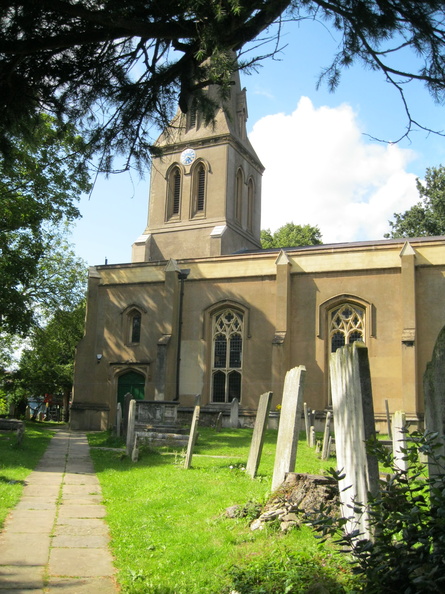St Leonard's Churchyard (Lambeth)
Brief Description
The parish of Streatham developed in the Middle Ages, and the medieval church of St Leonard in the middle of the village was rebuilt in the mid C14th. By then Streatham had become wealthier largely due to its position halfway between the palaces of the Archbishops of Canterbury at Lambeth and Croydon, and the village grew up around the main road. St Leonard's churchyard was reputedly the burial place for people who were 'found dead', presumably murdered by highwaymen and other criminals on Streatham Common. There are fine mature trees particularly around the edge of the churchyard and monuments date from the C19th. Part of the churchyard to the west was once part of St Leonard's Rectory Garden.
Practical Information
- Previous / Other name:
- Streatham Parish Church
- Site location:
- Streatham High Road/Mitcham Lane, Streatham
- Postcode:
- SW16 1HS
- What 3 Words:
- bottle.almost.jets
- Type of site:
- Churchyard
- Borough:
- Lambeth
- Open to public?
- Yes
- Opening times:
- unrestricted
- Special conditions:
- Facilities:
- Events:
- Public transport:
- Rail: Streatham. Bus: 50, 57, 109, 118, 133, 159, 201, 249, 250, 255, 315, 319, 333, G1, P13
- Research updated:
- 05/09/2023
- Last minor changes:
- 05/09/2023
Please check with the site owner or manager for latest news. www.stleonard-streatham.org.uk
Full Site Description
After the Great Fire of London Streatham was one of the places that City merchants chose to move to, as was Clapham, and the discovery of medicinal springs at Streatham Common brought further popularity. The Manor of Streatham and patronage of the parish church passed through a number of owners, including Eton College in 1439, and from 1599 it was owned by the Howland family, passing to the Duke of Bedford after Elizabeth Howland's marriage in 1695 to the Marquis of Tavistock, and it remained in the Duke's ownership until the C20th.The lower part of the church tower dates from the early church, the tower arch from the C14th and the rest of the building is of more recent date. It was rebuilt in 1778 when a spire was added, and further alterations took place in 1831. A fire in 1975 destroyed much of the interior, but it was restored and opened two years later.
The church contains a number of fine monuments for the notable local dignitaries who worshipped here, who included Edmund Tylney (d.1610), who was Master of the Revels to Elizabeth I and James I, and the Thrale family of Streatham Place. Henry Thrale was a wealthy brewer and MP for Southwark, and among the guests that he and his wife Hester entertained were Samuel Johnson and James Boswell. The Thrale memorials for Henry and his mother-in-law, Mrs Salusbury, have Latin epitaphs by Dr Johnson. The fountain by William Dyce RA, now located at Streatham Green (q.v.) used to be located opposite the church.
Part of the churchyard to the west was once part of St Leonard's Rectory Garden, as shown on the OS Map 25 " CXXXV published in 1897. The churchyard is marked 'Disused' on the 1894 London XV.13 OS Map.
The churchyard contains some good C19th monuments, including listed chest tombs of George Abell (d.1826); Joseph Hay (d.1805) and Lt Col William Boyce (d.1808), both of Coadestone and railed; and of Thomas Helps (d.1842) and members of his family. One of his sons, Sir Arthur Helps (d.1875) was clerk of the Privy Council from 1860 until his death and was responsible for preparing a number of volumes of Queen Victoria's writings and an edition of Prince Albert's speeches. By the 1990s the churchyard had become neglected and vandals had damaged many of the old tombstones and graffitied the church walls. A major restoration project was undertaken in 1999, since when it has been enclosed with fencing and gates, replacing wrought iron railings removed in WWII. Paths have been re-laid and damaged monuments repaired, with lighting and seating provided and trees pruned and managed. A new mowing regime was instigated for aesthetic reasons and to encourage wildlife and in 2008/9 a plant survey undertaken by the South London Botanical Institute (q.v.) identified around 109 different plants. Unfortunately further vandalism took place in 2011, when the south door of the church was burnt and a number of tombs were damaged, but the churchyard has since re-opened. Trees in the churchyard include cedar of Lebanon, common lime, hornbeam, yew, walnut and Lucombe oak. The Streatham Society, which looks after the churchyard, has produced a book about it, 'The Dead Centre of Streatham'.
Environmental improvements in the churchyard have been undertaken through the church's Eco Church programme, which has included opening up boundaries along Tooting Bec Gardens and Streatham High Road to make it more open and welcoming, and the planting of native bulbs and hedges. Restoration work is also taking place to restore as many of the historically important monuments as possible, as well as provide improved interpretation about the churchyard’s rich history and wildlife importance.
Sources consulted:
Ian Yarham, Michael Waite, Andrew Simpson, Niall Machin, 'Nature Conservation in Lambeth', Ecology Handbook 26 (London Ecology Unit), 1994; Streatham Society 'The Dead Centre of Streatham'. History of the church and its churchyard on St Leonard's Church website: https://stleonard-streatham.org.uk/place/churchyard/
Further Information (Planning and Conservation)
- Grid ref:
- TQ299717 (529979,171717)
- Size in hectares:
- 0.4
- Site ownership:
- Diocese of Southwark
- Site management:
- Streatham Society
- Date(s):
- C14th on
- Designer(s):
- Listed structures:
- LBII: St Leonard's Church; Chest tombs for George Abell. Lt Col William Boyce, Joseph Hay, Thomas Helps and family
- On National Heritage List for England (NHLE), Parks & Gardens:
No- Registered common or village green on Commons Registration Act 1965:
No- Protected under London Squares Preservation Act 1931:
No
Local Authority Data
The information below is taken from the relevant Local Authority's planning legislation, which was correct at the time of research but may have been amended in the interim. Please check with the Local Authority for latest planning information.
- On Local List:
- No
- In Conservation Area:
- Yes
- Conservation Area name:
- Streatham High Road and Streatham Hill
- Tree Preservation Order:
- No
- Nature Conservation Area:
- Yes - Local
- Green Belt:
- No
- Metropolitan Open Land:
- No
- Special Policy Area:
- Yes - Archaeological Priority Area
- Other LA designation:
- None
Photos
St Leonard's Churchyard - Photo: Colin Wing
Date taken: 10/08/21 15:36Click a photo to enlarge.
Please note the Inventory and its content are provided for your general information only and are subject to change. It is your responsibility to check the accuracy.






